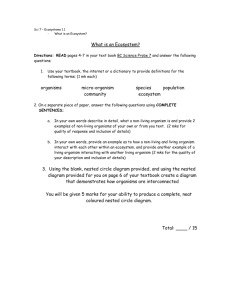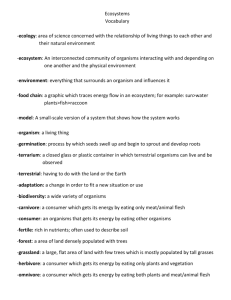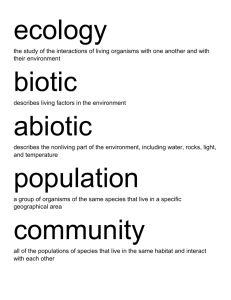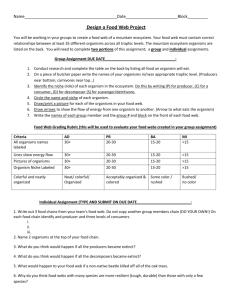photosynthesis
advertisement
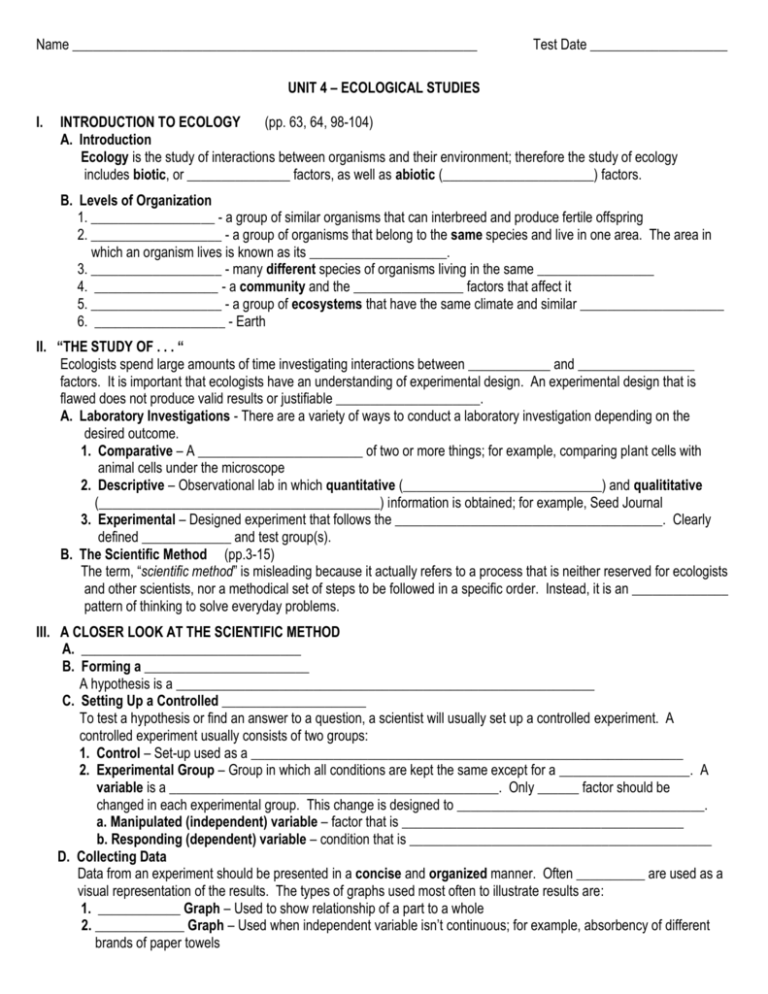
Name ___________________________________________________________ Test Date ____________________ UNIT 4 – ECOLOGICAL STUDIES I. INTRODUCTION TO ECOLOGY (pp. 63, 64, 98-104) A. Introduction Ecology is the study of interactions between organisms and their environment; therefore the study of ecology includes biotic, or _______________ factors, as well as abiotic (______________________) factors. B. Levels of Organization 1. __________________ - a group of similar organisms that can interbreed and produce fertile offspring 2. ___________________ - a group of organisms that belong to the same species and live in one area. The area in which an organism lives is known as its ____________________. 3. ___________________ - many different species of organisms living in the same _________________ 4. __________________ - a community and the ________________ factors that affect it 5. ___________________ - a group of ecosystems that have the same climate and similar _____________________ 6. ___________________ - Earth II. “THE STUDY OF . . . “ Ecologists spend large amounts of time investigating interactions between ____________ and _________________ factors. It is important that ecologists have an understanding of experimental design. An experimental design that is flawed does not produce valid results or justifiable _____________________. A. Laboratory Investigations - There are a variety of ways to conduct a laboratory investigation depending on the desired outcome. 1. Comparative – A ________________________ of two or more things; for example, comparing plant cells with animal cells under the microscope 2. Descriptive – Observational lab in which quantitative (_____________________________) and qualititative (_________________________________________) information is obtained; for example, Seed Journal 3. Experimental – Designed experiment that follows the _______________________________________. Clearly defined _____________ and test group(s). B. The Scientific Method (pp.3-15) The term, “scientific method” is misleading because it actually refers to a process that is neither reserved for ecologists and other scientists, nor a methodical set of steps to be followed in a specific order. Instead, it is an ______________ pattern of thinking to solve everyday problems. III. A CLOSER LOOK AT THE SCIENTIFIC METHOD A. ________________________________ B. Forming a ________________________ A hypothesis is a _____________________________________________________________ C. Setting Up a Controlled _____________________ To test a hypothesis or find an answer to a question, a scientist will usually set up a controlled experiment. A controlled experiment usually consists of two groups: 1. Control – Set-up used as a _______________________________________________________________ 2. Experimental Group – Group in which all conditions are kept the same except for a ___________________. A variable is a ________________________________________________. Only ______ factor should be changed in each experimental group. This change is designed to ____________________________________. a. Manipulated (independent) variable – factor that is _________________________________________ b. Responding (dependent) variable – condition that is ____________________________________________ D. Collecting Data Data from an experiment should be presented in a concise and organized manner. Often __________ are used as a visual representation of the results. The types of graphs used most often to illustrate results are: 1. ____________ Graph – Used to show relationship of a part to a whole 2. _____________ Graph – Used when independent variable isn’t continuous; for example, absorbency of different brands of paper towels 3. ____________ Graph – Used when ___________________ variable is continuous; for example, time. A line graph most clearly shows the relationship between the independent & dependent variables in an experiment. In a line graph, the manipulated (independent) variable is plotted on the _____ axis and the responding (dependent) variable is plotted on the ___ axis. Manipulated (Independent) Variable: _____________________________ Responding (Dependent) Variable: __________________________ E. Analysis and Conclusion After collecting data, a scientist must analyze the data and form conclusions based on the following questions: 1. Do the results ___________ or __________________ the ____________________________? 2. Is the experimental set-up _____________? a. Was there a large enough ______________________? b. Although no experimental set-up can be perfect, were the ________________________________ minimized? c. Was there only _______________________________ tested? 3. Is the experiment ________________________? F. Constructing a Theory A scientific theory is an explanation that has been ___________________ many times by many different ____________________. Although a theory has been confirmed by repeated experiments, it may eventually be _______________________. IV. ENERGY FLOW (pp. 67-73) All living things require energy. The ultimate source of energy for the earth is the __________. A. Autotrophs – “_________________________”. They are also known as _________________. Most producers capture energy from the sun in a process called _________________________. Photosynthesis takes place in the ___________________________ of plant cells. The equation for photosynthesis is __________________________________________________________________________________________. B. Heterotrophs – Organisms that have to _______________________ are called heterotrophs or _______________. There are several categories of consumers: 1. Herbivores – Eat _______________________________________________________ 2. Carnivores – Eat ________________________________________________________ 3. Omnivores – Eat ________________________________________________________ 4. Detritivores – Obtain energy from ______________ bodies of plants and animals; for example, ____________ ______________________________________ 5. Decomposers – Break down _________________ matter. Most decomposers are in Kingdom ___________________ or Kingdom ____________________. C. Energy in a Cell – All organisms (_______________________ and _________________________) must convert _____________ energy present in _______________ and other food molecules into usable energy. This conversion process is known as ___________________ and the end-product is a re-chargeable “battery” used by all cells for energy known as _____________. Most ATP is produced through the process of ___________________________. The equation for cellular respiration is ______________________________________________________________________________________. V. ENERGY FLOW – A COMPARISON OF PHOTOSYNTHESIS & CELLULAR RESPIRATION (p. 232) PHOTOSYNTHESIS CELLULAR RESPIRATION Function Cell Location Occurs In Reactants Products Overall Reaction VI. TRACING ENERGY FLOW A. Trophic Levels - Each step in the pathway of energy flow is known as a __________________________. The first trophic level is always a ____________________. The 2nd trophic level is known as the primary (1 o) ____________ and may be an ____________________ or ____________________. The last step is always a _________________________. B. Food Chains – A food chain illustrates how energy is transferred by showing ________________________________ _________________________________________. The arrows show the direction of _________________________. Which organism acts as a secondary consumer? According to this food chain, which organism could be described as an herbivore? Which organism is the producer? What are two terms that could be used to describe the hawk? C. Food Webs – Typically feeding relationships are more complex than illustrated in a food chain. Most organisms eat ___________________________________________________ and ___________________________________ a variety of organisms. These interconnected pathways are more accurately shown in a food web. According to this food web . . . How many different producers are there? Is the grasshopper a producer, primary, or secondary consumer? Is the grasshopper an herbivore, carnivore, or omnivore? What organism(s) acts as the decomposer? Give an example of an organism in this food web that acts as secondary and tertiary consumer. If all the squirrels in the community perished, would the hawk be able to survive? Explain. If the grass was destroyed, which organism would be most directly affected? Explain. D. Ecological Pyramids – Although in theory, a food ____________ or food ___________ can consist of unlimited numbers of __________________________, in actuality this does not take place. On average, only ________% of the energy stored in an organism is passed to the next trophic level. ________% of the energy is either used by the organism to maintain ____________________ or lost as ___________ to the environment. Because of this, most food chains typically consist of only _____ or ______ trophic levels. Ecologists use ______________________ to represent the amount of ________________ or _______________ at each _____________________________. Pyramid of Numbers VII. NUTRIENTS IN AN ECOSYSTEM (pp. 74-80) Unlike energy from the sun, nutrients are only available to an ecosystem in specific quantities and must be _________________ within and between ecosystems. Nutrients may become a _____________________________ when they are depleted. Organisms require nutrients to ___________________________________________________. Although all nutrients, including ____________, are re-cycled, there are a few nutrient cycles that are especially important. A. Water Cycle B. Carbon Cycle – Organisms require carbon to make _______________________, _____________, _________________, and __________________________. Carbon dioxide in the atmosphere is taken up by ____________ and _____________ for ___________________. (Algae are autotrophic, unicellular organisms with cell walls made of cellulose and chloroplasts that belong to kingdom ______________.). They produce glucose for _______________________________. Humans and other _________________ eat plants & algae, or they eat other organisms who have eaten plants & algae. The carbon from glucose is returned to the atmosphere as __________, a waste product of cellular respiration. In addition, erosion, burning of _____________________, and _____________________ recycle carbon. C. Nitrogen Cycle – Organisms require nitrogen to build ________________ and ____________________. The _________________ is mostly nitrogen, but only ____________________ produce the _________________ needed to convert nitrogen from the atmosphere to a useable form, a process known as _____________ ___________________. After nitrogen fixation is carried out by bacteria in soil, the nitrogen compound in the soil is then absorbed by ______________ and used to make __________ and ___________________. When other organisms ___________________________________, they can re-use the nitrogen to build their own ____________ and _____________________. When organisms die, _______________________ return the nitrogen to the soil where it may be taken up by _________________ again or returned to the atmosphere by other ______________. UNIT 5 – ECOLOGICAL STUDIES D. Phosphorus Cycle - All organisms require phosphorus for _____, _______, _______, and the ____________________________ of the cell membrane. Phosphorus is found in soil and rocks, absorbed by the ____________ of plants, where it is transported through the rest of the plant by the ________________. ______________________ eat plants, which is then returned to the soil E. Nutrient Limitation – When nutrients are scarce in an ecosystem, they are described as __________________ _________________. This imposes restrictions on the number of organisms, an organism’s growth, and the ______________________________ of the system. For example, run-off from fertilized fields can trigger algae blooms in aquatic systems. VIII. ECOLOGICAL SUCCESSION (pp. 94-97) Ecosystems are constantly changing in response to natural and human disturbances. As an ecosystem changes, older Inhabitants gradually die out and new organisms move in, resulting in further changes in the community. Ecological succession refers to a series of _____________________ changes that occur in a _____________________ over time. A. Primary Succession – Occurs following destruction of ___________; for example, after _________________ eruption, glaciers melting First species to populate area known as ____________________ species Lichens are the most common pioneer species after a volcano because they are capable of growing on bare rock. A lichen is a ____________ and ______________ living together. Cyanobacteria are ____________________ bacteria. In a lichen, the cyanobacteria provides _________ for the fungus and the fungus provides _________ and _____________________ for the cyanobacteria. B. Secondary Succession – Occurs when a disturbance of some kind changes an existing community without removing the ____________; for example, ___________, clearing land. IX. ECOSYSTEM INTERACTIONS (pp. 90-93) Ecosystems are influenced by a combination of _____________ factors and _______________ factors. Together they determine the health of an ecosystem and its _____________________. A. The Niche - The role an organism plays in its _________________ is its _____________. An organism’s niche is comprised of _________ and ___________ factors, for example, the type of food it eats, how it obtains its food, the way it is food for other organisms, how & when it reproduces, its physical living requirements to survive, etc. B. Interactions Within a Community – Community interactions have a powerful effect on an ecosystem: 1. Competition – Competition occurs when organisms are attempting to use the same __________________ at the same time. Each different species within a community must have its own ___________. Competitive Exclusion Principle – No two species can occupy the same ________ in the same __________________ at the same time. 2. Predation – The organism that does the killing and eating is the ________________ and the food organism is the _____________. 3. Symbiosis – A relationship in which two organisms _______________________________________ is described as symbiosis. There are three main types of symbiotic relationships: a. Mutualism – Both organisms ____________. For example, virtually all plant roots have mycorrhizae – a ________________ that resides within the plant roots. Fungus enhances absorption of _____________ and ______________ in roots; plant provides ______________ for the fungus. b. Commensalism – In commensalism, only one organism benefits, but the other organism ________________. For example, barnacles are small ___________________ that often attach themselves to whales. They do not harm the whales, and the barnacles benefit from the _________________________________________. c. Parasitism – In parasitism, only one organism benefits and the other organism is ______________ by the relationship. The organism that is harmed is known as the _______. Examples of parasites include ___________________________________________________________________. X. POPULATIONS WITHIN AN ECOSYSTEM (pp. 124-127) Populations within an ecosystem cannot have unlimited growth. There are conditions that have an impact on population size known as ________________________. Limiting factors may described as density-dependent or density-independent. A. Density-Dependent Limiting Factors – Density-dependent factors depend on population size; for example, __________________ and availability of _____________, ____________________, and _______________________. B. Density-Independent Limiting Factors – These are factors that affect all populations the same way, regardless of size. Examples include _____________________________________, _______________ __________________, and human activities such as ________________________________________ ___________________________________________________________________________________ C. Climax Community – A climax community is a ______________ community with very little population growth or decline. Each ecosystem has a ___________________________, a certain number of organisms that can exist _______________________. When the carrying capacity is exceeded, resources become a ______________________________, and population numbers _______________.





